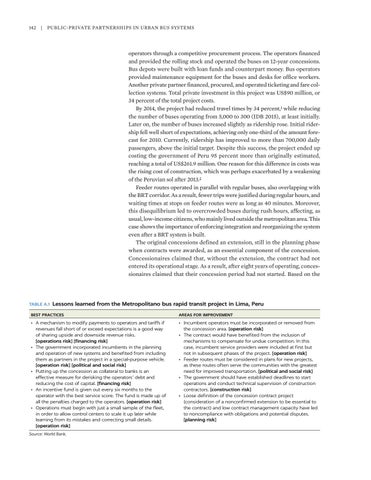142 | Public-Private Partnerships in Urban Bus Systems
operators through a competitive procurement process. The operators financed and provided the rolling stock and operated the buses on 12-year concessions. Bus depots were built with loan funds and counterpart money. Bus operators provided maintenance equipment for the buses and desks for office workers. Another private partner financed, procured, and operated ticketing and fare collection systems. Total private investment in this project was US$90 million, or 34 percent of the total project costs. By 2014, the project had reduced travel times by 34 percent,1 while reducing the number of buses operating from 5,000 to 300 (IDB 2015), at least initially. Later on, the number of buses increased slightly as ridership rose. Initial ridership fell well short of expectations, achieving only one-third of the amount forecast for 2010. Currently, ridership has improved to more than 700,000 daily passengers, above the initial target. Despite this success, the project ended up costing the government of Peru 95 percent more than originally estimated, reaching a total of US$261.9 million. One reason for this difference in costs was the rising cost of construction, which was perhaps exacerbated by a weakening of the Peruvian sol after 2013.2 Feeder routes operated in parallel with regular buses, also overlapping with the BRT corridor. As a result, fewer trips were justified during regular hours, and waiting times at stops on feeder routes were as long as 40 minutes. Moreover, this disequilibrium led to overcrowded buses during rush hours, affecting, as usual, low-income citizens, who mainly lived outside the metropolitan area. This case shows the importance of enforcing integration and reorganizing the system even after a BRT system is built. The original concessions defined an extension, still in the planning phase when contracts were awarded, as an essential component of the concession. Concessionaires claimed that, without the extension, the contract had not entered its operational stage. As a result, after eight years of operating, concessionaires claimed that their concession period had not started. Based on the
TABLE A.1 Lessons
learned from the Metropolitano bus rapid transit project in Lima, Peru
BEST PRACTICES
AREAS FOR IMPROVEMENT
• A mechanism to modify payments to operators and tariffs if revenues fall short of or exceed expectations is a good way of sharing upside and downside revenue risks. [operations risk] [financing risk] • The government incorporated incumbents in the planning and operation of new systems and benefited from including them as partners in the project in a special-purpose vehicle. [operation risk] [political and social risk] • Putting up the concession as collateral to banks is an effective measure for derisking the operators’ debt and reducing the cost of capital. [financing risk] • An incentive fund is given out every six months to the operator with the best service score. The fund is made up of all the penalties charged to the operators. [operation risk] • Operations must begin with just a small sample of the fleet, in order to allow control centers to scale it up later while learning from its mistakes and correcting small details. [operation risk]
• Incumbent operators must be incorporated or removed from the concession area. [operation risk] • The contract would have benefited from the inclusion of mechanisms to compensate for undue competition. In this case, incumbent service providers were included at first but not in subsequent phases of the project. [operation risk] • Feeder routes must be considered in plans for new projects, as these routes often serve the communities with the greatest need for improved transportation. [political and social risk] • The government should have established deadlines to start operations and conduct technical supervision of construction contractors. [construction risk] • Loose definition of the concession contract project (consideration of a nonconfirmed extension to be essential to the contract) and low contract management capacity have led to noncompliance with obligations and potential disputes. [planning risk]
Source: World Bank.

